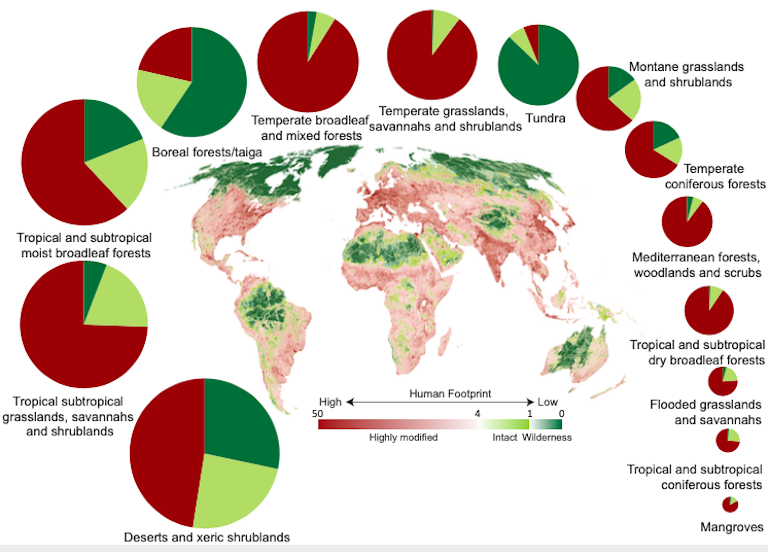- A new study has found that human activities contributed to the loss of 1.9 million square kilometers (734,000 square miles) of intact land between 2000 and 2013, and that more than half of the world is under moderate or intense pressure from humanity.
- The most substantial losses occurred in tropical and subtropical grassland, savanna, and shrublands, while the most intact regions were tundras, boreal and taiga forests, deserts and xeric shrublands.
- The team is currently working on an update to produce near real-time results of land degradation for the past seven years.
- These findings can help inform policies and aid conservation monitoring efforts, according to the researchers.
Humans have not treaded lightly on the Earth. Over the centuries, we have left our mark on almost every ecosystem, contributing to a steady, and increasingly rapid, decline in the world’s natural places.
A new study published in One Earth found that more than half of the world is under moderate or intense pressure due to humanity, and that between 2000 and 2013, about 1.9 million square kilometers (734,000 square miles) of intact land — about the size of Mexico — has been modified to the point of devastation.

Lead author Brooke Williams, a doctoral candidate at the University of Queensland in Australia, said the findings caught her by surprise.
“We were expecting there to be high levels of intact ecosystem and wilderness loss, but the results were shocking,” Williams told Mongabay in an email. “A lot of biodiversity requires intact land for survival, and people rely on the services that intact ecosystems provide. Climate change mitigation efforts are also undermined by these losses because intact lands make crucial contributions to the terrestrial carbon sink, so it really is cause for concern.”
Williams and her colleagues used a method of human pressure mapping called the “human footprint,” which tracked eight pressures on the natural world: built environments, population density, nighttime lights, crop lands, pasture lands, roads, railways, and navigable waterways. This data set relied mainly on satellite imagery, but also used census data for things like population density, Williams said.
“We are in the era of big data, where we can draw on these massive global datasets to answer some really tough and important questions,” she said. “It is crucial that we understand what changes Earth is going through, so that we can realise the damage we are doing, identify the regions that are really in trouble, and focus conservation and sustainable development efforts towards … crisis regions or ecosystems.”

The authors categorized the world’s ecosystems into 14 biomes consisting of 795 ecoregions, and found that during the study period, intact land disappeared from each biome, with the most substantial losses occurring in tropical and subtropical grassland, savanna, and shrublands.
“We are quickly running out of time,” senior author James Watson, professor at the University of Queensland and director of the science and research initiative at the Wildlife Conservation Society (WCS), told Mongabay. “Once those intact places have been degraded by human industry, they can never be returned, and that has huge consequences for biodiversity and climate agendas as well as the sustainable development goals.”
On the other hand, the study showed that 42% of the terrestrial Earth was relatively “free of direct anthropogenic disturbance,” and that 25% of land could still be considered “wilderness” with very little human disturbance. The most intact biomes included tundras, boreal and taiga forests, deserts and xeric shrublands, and the countries boasting the highest levels of intact land were Russia, Canada, Brazil, and Australia, according to the research.
There are no data available from 2013 to the present day, but Watson says the team is working to produce an update with near real-time results. This won’t be released for at least a few months, however.

“We think that … the last seven years hasn’t been pretty,” Watson told Mongabay. “We know that in places like Australia … there has been quite significant land clearing for agriculture and for development. And countries like Brazil, in the last couple of years, have really opened up intact landscapes around the country to agriculture and industry, so we won’t be surprised to see some quite devastating results there.”
While the findings are grim, Williams says it’s a great opportunity to use the results to inform policies, such as the U.N. Convention on Biological Diversity’s post-2020 global biodiversity framework.
“This is a timely opportunity for nations to take stock and to set explicit targets for retaining Earth’s remaining intact lands,” she said. “Proactively protecting Earth’s intact ecosystems is humanity’s best mechanism for protecting against climate change, ensuring large-scale ecological and evolutionary processes persist, and safeguarding biological diversity into the future. We can’t afford to lose any more.”
Watson says near real-time assessment of habitat loss can provide a powerful tool for conservationists to demand nations take action on land degradation issues.
“These mapping efforts will get easier and easier,” he said. “Gone are the days that nations can claim that we can’t measure this, so we’ve got to take a year or two to get statistics back into the hands of [governing] bodies … there’s no excuse, we should be able to set really ambitious targets and monitor progress towards those targets through these mapping efforts. That’s exciting for the conservation community.”
Citation:
Williams, B. A., Venter, O., Allan, J. R., Atkinson, S. C., Rehbein, J. A., Ward, M., … Watson, J. E. M. (2020). Change in terrestrial human footprint drives continued loss of intact ecosystems. One Earth, 3(3), 371-382. doi:10.1016/j.oneear.2020.08.009
Banner image caption: Landcover, forest clearance and plantation development in PT Megakarya Jaya Raya (PT MJR) palm oil concession. Image by Greenpeace International.
Elizabeth Claire Alberts is a staff writer for Mongabay. Follow her on Twitter @ECAlberts.
FEEDBACK: Use this form to send a message to the author of this post. If you want to post a public comment, you can do that at the bottom of the page.
